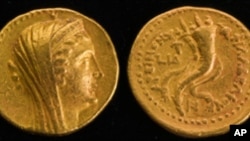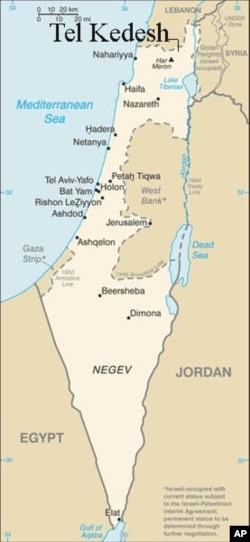Archaeologists working in northern Israel say they have unearthed the heaviest and most valuable gold coin ever found in the country. The 2,200-year-old coin is thought to have been minted by the ancient Egyptian ruler Ptolemy V. It was uncovered at Tel Kedesh, near the border with Lebanon. Scientists say it was minted in Alexandria around 191 BC and bears the name of Arsinoë II Philadephus, the wife of Ptolemy II Philadephus.
Arsinoë II was married at age 15 to one of Alexander the Great's generals, Lysimachus, the king of Thrace. After Lysimachus' death she married her brother, Ptolemy II, who established a cult in her honor.
Donald T. Ariel, head of the coin department at the Israel Antiquities Authority, told the Associated Press this coin is only the second Ptolemaic coin ever found in Israel. "It must have been equivalent to half a year or a year's salary in one coin," Ariel says.
Ariel notes the coin has ceremonial or symbolic significance and was probably meant to be used in a temple dedicated to Queen Arisonë. He adds that although the inscription on the coin identifies the queen as Arsinoë Philadelphus, sometimes coins from this era actually depict cryptic portraits of the reigning queens. That would mean the woman represented on the Tel Kedesh coin may actually be Cleopatra I, daughter of Antiochus III, whose marriage to Ptolemy V in 193 BC sealed the formal end of the Fifth Syrian War.
The excavations at Tel Kedesh are under the auspices of the University of Michigan and University of Minnesota. Since the digging started in 1997, workers have uncovered a large Persian-Hellenistic administrative building, complete with reception halls, dining facilities, store rooms and an archive.
Sharon Herbert, Director of the Kelsey Museum in Michigan and one of the directors of the excavation, says finding this type of coin is extremely rare, particularly because it is gold.
Andrea Berlin of Boston University is a co-director of the dig at Tel Kedesh. She says the coin could represent a ceremonial gift between the ancient Egyptian empire and the Seleucids of Syria.
"What this really had to have commemorated was not just something official and ceremonial but also deeply political because hegemony of the region we now know of today as Israel, Jordan, and Lebanon all transferred from Egyptian hegemony to Syrian hegemony," Berlin says.
Sharon Herbert says it is no coincidence that the region around Tel Kedesh continues to be a site of conflict, including a clash between Israeli troops and Lebanese soldiers when Israel cut a tree in Lebanese territory.
"Some things never change," Herbert says, "this is a border area. It was a border area under the Egyptian pharaohs; it was a border area in Hellenistic Greece. It's a border area today. Its fate is to pass back and forth among stronger kingdoms."
Sharon Herbert says her team is going to spend the next three years cataloging and publishing a book about their work on the building at Tel Kedesh. The digging has stopped for now, but Herbert says her team plans to return to the site once their work is published.







